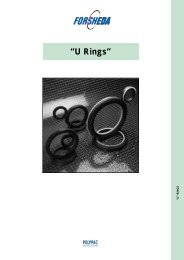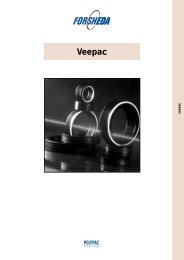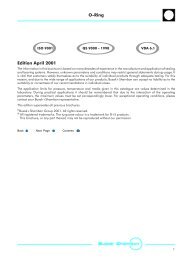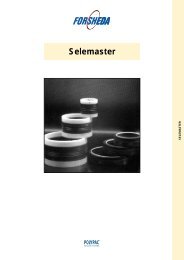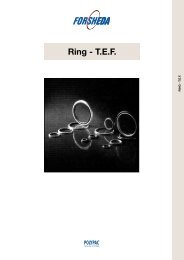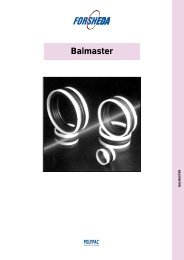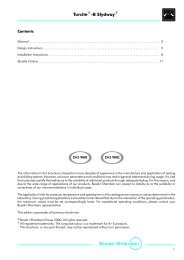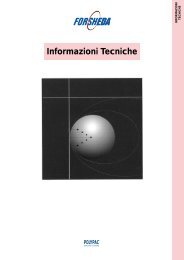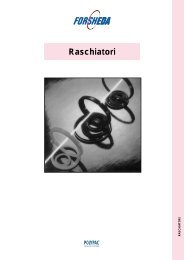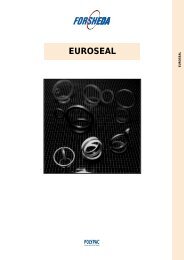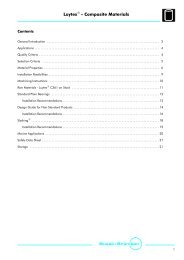Rotary Seals - Dilanda.it
Rotary Seals - Dilanda.it
Rotary Seals - Dilanda.it
Create successful ePaper yourself
Turn your PDF publications into a flip-book with our unique Google optimized e-Paper software.
Axial Shaft Seal<br />
n AXIAL SHAFT SEAL<br />
Axial shaft seals are used primarily as a protective seal for<br />
roller bearings. Their sizes are matched to those of roller<br />
bearings. If fluids are to be prevented from escaping, a<br />
design w<strong>it</strong>h an internal seal lip, is to be preferred.<br />
The design w<strong>it</strong>h external sealing lip is su<strong>it</strong>able for sealing<br />
grease and for protection against dirt entering from the<br />
outside.<br />
In both types of construction the elastomer seal lip is axially<br />
spring-loaded against the oppos<strong>it</strong>e mating face by a spider<br />
spring. The linear compressive force is lower than w<strong>it</strong>h an<br />
oil seal (about one third), but constant in operation. There<br />
is no reduction in contact force due to thermal expansion<br />
as w<strong>it</strong>h oil seals, and the larger diameter of the sliding seal<br />
edge has an unessential influence on the friction effect.<br />
Advantages<br />
- Low friction, minimum heat generation<br />
- No shaft wear<br />
- Minimum installation space requirement<br />
- Simple installation<br />
- High heat resistance<br />
- High sliding speed<br />
- Su<strong>it</strong>able for a wide range of roller bearing series<br />
- Long service life<br />
n General<br />
Axial shaft seals are ready-to-install seal elements for<br />
sealing shafts, axles and bearings.<br />
The Axial shaft seal consists of an elastomer-elastic<br />
membrane w<strong>it</strong>h a vulcanised metallic reinforcement ring.<br />
The membrane has an axial sealing lip. The sealing lip is<br />
designed in a conical form to obtain a minimum contact<br />
area, thus considerably reducing friction, heat and wear.<br />
The sturdy form ensures a proper f<strong>it</strong> w<strong>it</strong>h the shaft or<br />
housing. A metallic spider spring is used to energize the<br />
seal lip (Figure 74).<br />
Characteristics<br />
Axial shaft seals have axial spring load against the mating<br />
surface. The seal requires very l<strong>it</strong>tle mounting space and<br />
can be effectively used where space is lim<strong>it</strong>ed.<br />
Method of Operation<br />
The sealing lip is pressed axially against the mating surface<br />
which must be perpendicular to the axis of the shaft. The<br />
seal membrane and the spider spring pressing against the<br />
back of the sealing lip ensure a uniform and vibration-free<br />
contact pressure.<br />
The centrifugal force of fluid accelerated by the shaft<br />
reinforces the sealing effect.<br />
Static sealing against the shaft (Type A) or in the housing<br />
bore (Type I) is ensured by interference f<strong>it</strong> w<strong>it</strong>h the shaft or<br />
housing.<br />
Reinforcement ring<br />
Spider spring<br />
Sealing lip<br />
Figure 74 Axial shaft seal<br />
Membrane<br />
Latest information available at www.busakshamban.com<br />
Ed<strong>it</strong>ion April 2006<br />
177



